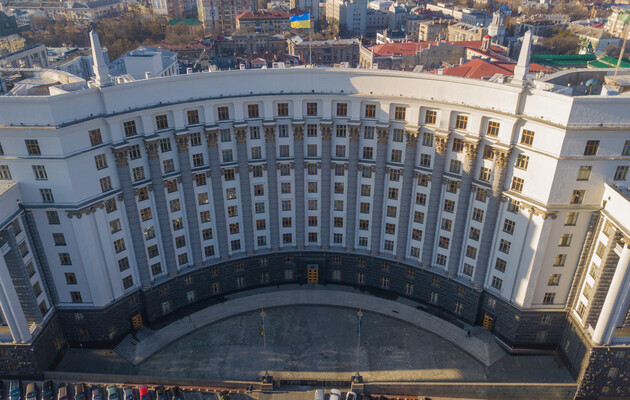Plan of Ukraine. 380 pages of the government's vision of the future, which are embarrassing
The government's 380-page "Ukraine Plan" is probably already on its way to the European Commission. It is a guarantee that we will receive 50 billion euros from the European Union under the Ukraine Facility program. It is currently our main strategy for economic recovery in the near term. Our prospects are not very promising.
The purpose of this document is to provide European partners with a plan of work, or rather, reforms, in exchange for the implementation of which we will receive the promised billions. At the same time, the first tranche of 4.5 billion euros at the end of March this year already arrived without any conditions, because the money was needed already today. However, it is unlikely that this will last forever, the mechanism provides not only money for reforms, but also fines for delays, namely 400 million euros for each overdue position of the Plan. With our experience, it is possible to go into the red. This probability can be confirmed by the International Monetary Fund (IMF).
But don't worry, this time government officials have prepared thoroughly: the lion's share of our reforms are concepts, plans, strategies, road maps and other waste paper. Something will definitely be written, and considering that most of the reforms did not start today, there will always be an opportunity to update the already existing and still unimplemented documents.
The only problem is that the real purpose of all these exercises should not be to report to the European Union or even to receive funds, but to reboot the country. In restarting its economy in such a way that overcoming the consequences of the war would not take half a century, but at least a dozen years. Well, if we achieve this, it will certainly not be through the efforts of the government.
It is impossible to retell everything, especially since in some places the plan is more like a flow of sporadic information, retrospective analyzes and alphabetical truths. Sometimes the wording in the plan is frankly inconvenient: "the system of monitoring and evaluation of results requires basing investments on the results of research on best practices." Almost four hundred pages are a lot of work time for both those who wrote them and those who will read them. These readers should be treated with more respect.
We deliberately ignored those points of the Plan that dealt with existing projects. For example, the entire section "Business environment" is a description of already existing programs and eternal reforms: "eRobota", loans "5-7-9", rebooting the Bureau of Economic Security of Ukraine (BES), support of industrial parks. And the reform of state finances is almost entirely focused on the National Revenue Strategy, which we have already written about. We also bypassed numerous meaningless "creation of conditions" and "improvement of efficiency", as well as variations on the development of a "complex political and normative legal framework". We grouped all more or less specific proposals from the Plan in a table (see at the end of the text). Quantitatively, it seems to be a lot, qualitatively - there is not a single, if not innovative, but at least fresh idea. The functional weakness of the current government is so obvious that it becomes embarrassing and a little shameful for the country.
One can only look at the scenario models, which for some reason replaced the analysis of the impact of the Plan's implementation in the document, with sadness and incomprehension of why this happened.
All three scenarios (basic, moderate and positive) declare the European integration of Ukraine and the changes that this process requires as the main driver. However, judging by the figures provided, the key factor and the only significant variable is the return of migrants: in the base scenario – 4 million people, in the moderate scenario – 5 million people, in the positive – all citizens, that is, about 6.3 million people.
The first question is methodological: if it is not known, and this is the current state of affairs, how many people do we currently have, including the working population, to which are added all these 4, 5, 6 million? Where does Gross domestic product (GDP) per capita come from? The projected GDP growth is also calculated in a strange way, because one variable, namely the number of employees, is definitely not the only component of this indicator. In some way, this variable affects other predictions of the future, for example, about foreign direct investment. The primitive logic of "more working hands, more development of investments" should not be offered, our graph of inflow of foreign direct investments has never even correlated with the population.
The second question is such that it includes the whole set of views and ideas of a person about the world. Why, realizing that the demographic crisis is unlikely to be solved successfully, did we insist on population size as a key factor? It is not the 19th century outside the window, modern production technologies no longer require thousands of workers, and the consumer market is not limited to the number of people in the country. If we've already been given these damn lemons, maybe we can make lemonade out of them by reshaping the economy in such a way that population is no longer the key for us? There are five million Irish people, and they do not get out of the top 10 in terms of GDP per capita. Just like Singaporeans, Norwegians, Swiss. Of course, this will require radical changes, bold ideas, technological advancement, and huge investments. But why do we need the "Plan of Ukraine" at all, if it is not about this?
However, this plan is not about this, and hence the third question: if we are already attached to the number of people as the basis of growth, how should the Government Plan affect all this?
According to it, migrants are planned to be returned by the adoption of a demographic strategy until 2040 with such "fresh" ideas as improving the birth rate, reducing the rate of premature mortality and promoting active longevity. The scenario models up to 2027 and even up to 2037 will not be affected by any incredible gains in fertility or mortality. Those born this year will enter the labor market around 2044, and the extension of life will give the current working population the opportunity to stay on the labor market a little longer, but will not provide new workers. If we rely on the Government Plan, then the adult population is needed for the development of the country already tomorrow, and its return will definitely not be affected by the longevity program. Citizens need answers to topical issues, but there are none.
It is difficult to find a less specific task than the restoration of housing. Now in our country there are people whose homes are either destroyed or occupied. And there is also the state, which must either build new housing for them, or issue compensation or provide them with an affordable mortgage so that they can purchase this housing themselves. It seems easy, but instead of this, we have in the Plan: defining the goals of the new housing policy and creating a national strategy. This is exactly what they write: "The creation of a legal framework and a national strategy will help increase the number of housing units." Given how sensitive this topic is right now, it looks like an outright mockery. It is expected that until the strategy is written and the goals of the housing policy are found, people will solve housing problems on their own either here or abroad - understandable, but cynical and short-sighted.
The adoption of a plan, law or strategy cannot be the result of a reform. We already have a lot of this type of document and it doesn't help us in any way. But strategies as a result are found in absolutely all sections of the Plan, from public administration reform to digitalization reform. How it was successfully implemented before this without a government action plan is now completely unclear.
Another systemic problem of the document is the lack of measurable evaluation criteria. Yes, there are deadlines, there are targets in the form of strategies and government plans, and there is a set of inappropriate and random adjectives instead of clear criteria. What does "revitalization of the domestic debt market" mean? Is 10% growth a recovery or not yet? And what is a "more effective anti-corruption infrastructure"? Where is the limit beyond which less efficient infrastructure becomes more efficient? And what does "strengthening the control system" mean? How is this strength determined – in pascals or percent by volume?
Everything more or less specific in the document is either reforms that are already underway (government, financial sector, deregulation, etc.) or renewal of existing programs. For example, it is planned to update the Small Business Development Strategy, the State Regional Development Strategy, the National Transport Strategy, the National Geological Strategy and other "vitally important" documents for the state.
It is clear that in the current presidential-centric system, the government is just a sham. Even if the current ministers had some bright ideas, non-standard approaches and motivation, everything rotted in the abyss between the streets of Instytutska and Bankova. The President of Ukraine wants something simple and preferably on his behalf. The government adjusts itself to these requirements. And now Yuliia Svyrydenko, who just a month ago told quite competently that our future is technology, processing and international production chains, is making a "cashback from the president" on Bankova Street at the request of political leaders.
Unfortunately, any expected changes in the government team will not affect its effectiveness, because this government, unlike the country, does not need a productive government with its own vision and proactive position. From the president's point of view, everything is clear. And since he is obviously not Lee Kuan Yew, we still have a long time to wait for the level of development of Singapore.
Read this article in Ukrainian and russian.
Please select it with the mouse and press Ctrl+Enter or Submit a bug












 Login with Google
Login with Google